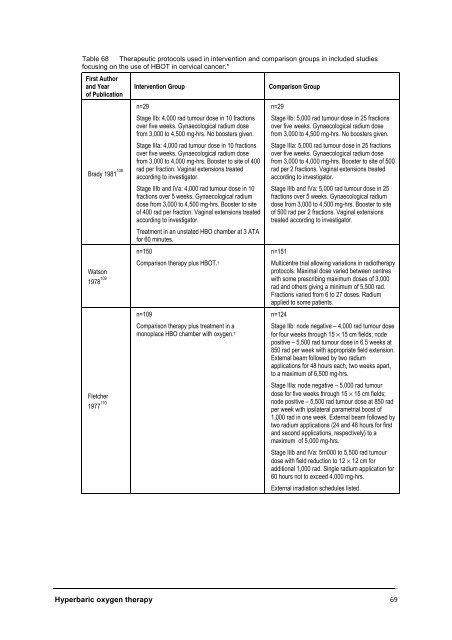Hyperbaric Oxygen Therapy - Hyperbaric Chamber Information ...
Hyperbaric Oxygen Therapy - Hyperbaric Chamber Information ...
Hyperbaric Oxygen Therapy - Hyperbaric Chamber Information ...
Create successful ePaper yourself
Turn your PDF publications into a flip-book with our unique Google optimized e-Paper software.
Table 68 Therapeutic protocols used in intervention and comparison groups in included studies<br />
focusing on the use of HBOT in cervical cancer.*<br />
First Author<br />
and Year<br />
of Publication<br />
Intervention Group Comparison Group<br />
Brady 1981 108<br />
Watson<br />
1978 109<br />
Fletcher<br />
1977 110<br />
n=29<br />
Stage IIb: 4,000 rad tumour dose in 10 fractions<br />
over five weeks. Gynaecological radium dose<br />
from 3,000 to 4,500 mg-hrs. No boosters given.<br />
Stage IIIa: 4,000 rad tumour dose in 10 fractions<br />
over five weeks. Gynaecological radium dose<br />
from 3,000 to 4,000 mg-hrs. Booster to site of 400<br />
rad per fraction. Vaginal extensions treated<br />
according to investigator.<br />
Stage IIIb and IVa: 4,000 rad tumour dose in 10<br />
fractions over 5 weeks. Gynaecological radium<br />
dose from 3,000 to 4,500 mg-hrs. Booster to site<br />
of 400 rad per fraction. Vaginal extensions treated<br />
according to investigator.<br />
Treatment in an unstated HBO chamber at 3 ATA<br />
for 60 minutes.<br />
n=150<br />
Comparison therapy plus HBOT. †<br />
n=109<br />
Comparison therapy plus treatment in a<br />
monoplace HBO chamber with oxygen. †<br />
n=29<br />
Stage IIb: 5,000 rad tumour dose in 25 fractions<br />
over five weeks. Gynaecological radium dose<br />
from 3,000 to 4,500 mg-hrs. No boosters given.<br />
Stage IIIa: 5,000 rad tumour dose in 25 fractions<br />
over five weeks. Gynaecological radium dose<br />
from 3,000 to 4,000 mg-hrs. Booster to site of 500<br />
rad per 2 fractions. Vaginal extensions treated<br />
according to investigator.<br />
Stage IIIb and IVa: 5,000 rad tumour dose in 25<br />
fractions over 5 weeks. Gynaecological radium<br />
dose from 3,000 to 4,500 mg-hrs. Booster to site<br />
of 500 rad per 2 fractions. Vaginal extensions<br />
treated according to investigator.<br />
n=151<br />
Multicentre trial allowing variations in radiotherapy<br />
protocols. Maximal dose varied between centres<br />
with some prescribing maximum doses of 3,000<br />
rad and others giving a minimum of 5,500 rad.<br />
Fractions varied from 6 to 27 doses. Radium<br />
applied to some patients.<br />
n=124<br />
Stage IIb: node negative – 4,000 rad tumour dose<br />
for four weeks through 15 × 15 cm fields; node<br />
positive – 5,500 rad tumour dose in 6.5 weeks at<br />
850 rad per week with appropriate field extension.<br />
External beam followed by two radium<br />
applications for 48 hours each, two weeks apart,<br />
to a maximum of 6,500 mg-hrs.<br />
Stage IIIa: node negative – 5,000 rad tumour<br />
dose for five weeks through 15 × 15 cm fields;<br />
node positive – 5,500 rad tumour dose at 850 rad<br />
per week with ipsilateral parametrial boost of<br />
1,000 rad in one week. External beam followed by<br />
two radium applications (24 and 48 hours for first<br />
and second applications, respectively) to a<br />
maximum of 5,000 mg-hrs.<br />
Stage IIIb and IVa: 5m000 to 5,500 rad tumour<br />
dose with field reduction to 12 × 12 cm for<br />
additional 1,000 rad. Single radium application for<br />
60 hours not to exceed 4,000 mg-hrs.<br />
External irradiation schedules listed.<br />
<strong>Hyperbaric</strong> oxygen therapy 69



